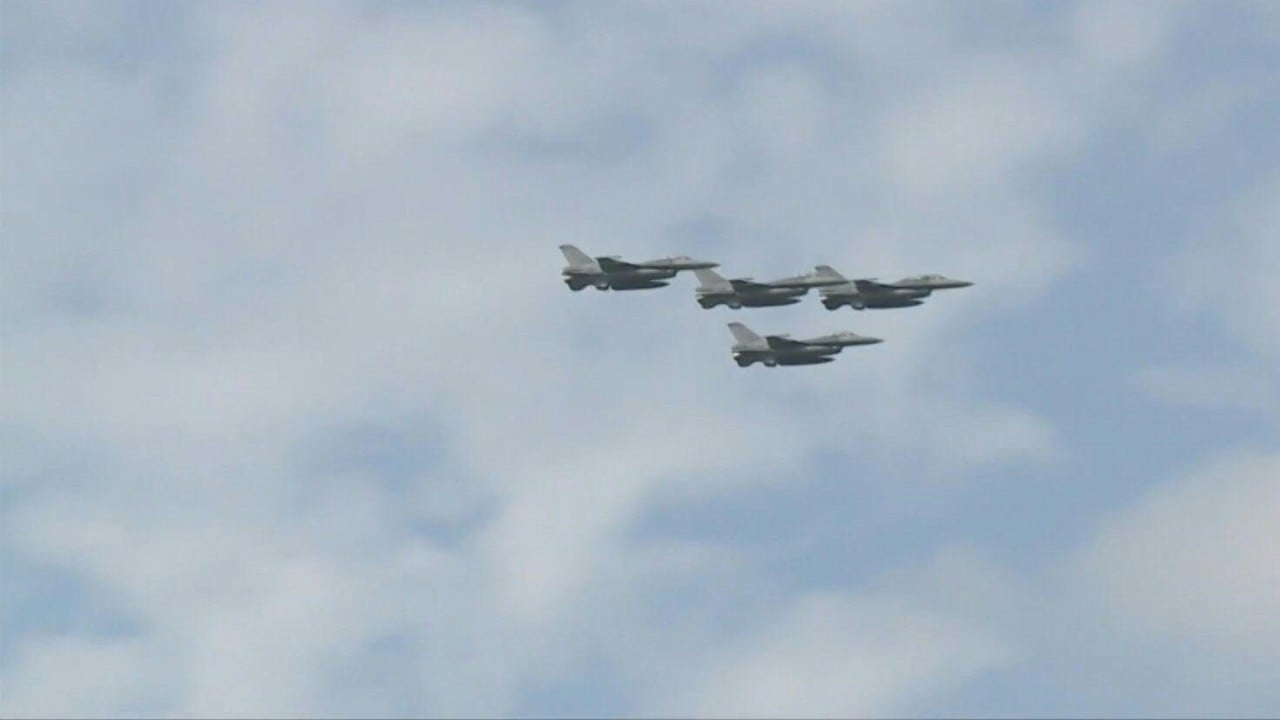
US seeks to speed delivery of new F-16s to Taiwan, as China piles on pressure
- The batch of 66 next generation aircraft, currently slated for 2026, would give the island one of the largest F-16 fleets in Asia
- Repeated missions to intercept increasingly aggressive Chinese planes are putting stress on Taiwan’s air force, which last year had several mishaps
The United States is looking for ways to potentially accelerate delivery of Taiwan’s next generation of new-build F-16 fighter planes, US officials said, bolstering the Taiwanese air force’s ability to respond to what Washington and Taipei see as increasing intimidation by China’s military.
The officials, speaking on condition of anonymity, said they have not yet come up with a solution on how to speed delivery of Block 70 F-16s, manufactured by Lockheed Martin and equipped with new capabilities. The aircraft are currently slated to be delivered by the end of 2026.
More missions mean more wear-and-tear on Taiwan’s aircraft.
“It’s all about risk assessment … and it’s clear where the risks are,” the Taiwanese official said, referring to tensions across the sensitive Taiwan Strait separating the island from mainland China. The F-16 is considered a highly manoeuvrable aircraft proven in air-to-air combat and air-to-surface attack.
Taiwan is on track to field one of the largest F-16 fleets in Asia once it takes delivery of 66 new-build F-16 C/D Block 70 aircraft under an US$8 billion deal approved in 2019. It would bring the island’s total number of F-16s, including older versions, to more than 200 by 2026.
Any move to accelerate deliveries of new aircraft could ultimately come down to a determination by Biden’s administration that Taiwan’s defence needs are more urgent than those of other US allies and partners, according to experts.
“That’s a Biden administration decision,” said Rupert Hammond-Chambers, the president of the US-Taiwan Business Council, an organisation that encourages trade and business ties between the two. “They would have to decide that the threat from China was more important than the threat from Iran or the threat from the Russians.”
Risk of war over Taiwan seen to be highest in past 25 years
The Block 70 aircraft are the newest F-16 configuration, with new avionics, a modernised cockpit and an improved engine, according to Lockheed Martin.
A move to accelerate the aircraft delivery would be seen in Beijing in part through a political lens, according to Abraham Denmark, a former senior Pentagon official.
“It is yet another clear signal of US determination to support Taiwan’s ability to defend itself,” added Denmark, now an analyst at the Washington-based Wilson Center think tank.
Despite lacking formal diplomatic ties with Taiwan, the United States is the island’s main international backer and arms supplier. That defence relationship angers China, which has ramped up military and diplomatic pressure against the island that it claims as “sacred” Chinese territory.

In the face of Chinese pressure, Taiwan President Tsai Ing-wen has prioritised modernising the armed forces, which are well-armed but dwarfed by China’s military.
Lockheed Martin declined to comment on any potential future requests to change the production schedule, referring queries to the US government and Taiwan’s defence ministry.
The US State Department, which oversees foreign military sales, declined to comment on any internal discussions about potential changes to the delivery timeline.
Lockheed Martin’s new F-16 production line in Greenville, South Carolina has several customers in the production queue ahead of Taiwan, including Bahrain, Slovakia and Bulgaria.
The US$8 billion defence plan that Taiwan hopes will deter mainland China
The US government has not asked Lockheed Martin for delivery timeline changes for the Taiwanese F-16 jets, a person familiar with the situation said.
The source declined to speculate about how much sooner Taiwan could get new-build F-16s even if a decision were made to accelerate deliveries. Any such effort would be complicated by production constraints, which include long lead times to source materials for Taiwan’s specific configuration of fighter aircraft.
Taiwan’s Air Force did not respond to questions on potential accelerated deliveries but said in a statement that the Taiwanese military’s major weapon purchases are “rigorously planned in accordance with actual combat needs and planning schedules”.
The US sale of F-16s to Taiwan was guided by US law and “based on an assessment of Taiwan’s defence needs and the threat posed by (China), as has been the case for more than 40 years,” a Pentagon spokesperson said in a statement.

The missions to intercept Chinese aircraft are putting stress on Taiwan’s air force, which last year had several mishaps, including three fatal crashes.
Over time, fuel costs, pilot fatigue and wear and tear on Taiwanese aircraft will threaten the readiness of the island’s air force if this pressure continues, Taiwanese and US military analysts said.
Last March, a senior Taiwanese official said Taiwan’s military had stopped intercepting every Chinese aircraft.
Fatigue from repeated Chinese sorties ‘contributed to Taiwan fighter jet crash’
Taiwan’s air force last week suspended combat training for its entire F-16 fleet after a recently upgraded model of the fighter jet crashed into the sea in the latest of a series of accidents.
“They (the Chinese) are wearing out their opponent without firing a shot,” said Derek Grossman, a senior defence analyst at the RAND Corporation.
Taiwan’s air force in 2020 scrambled 2,972 times against Chinese aircraft at a cost of US$905 million.


